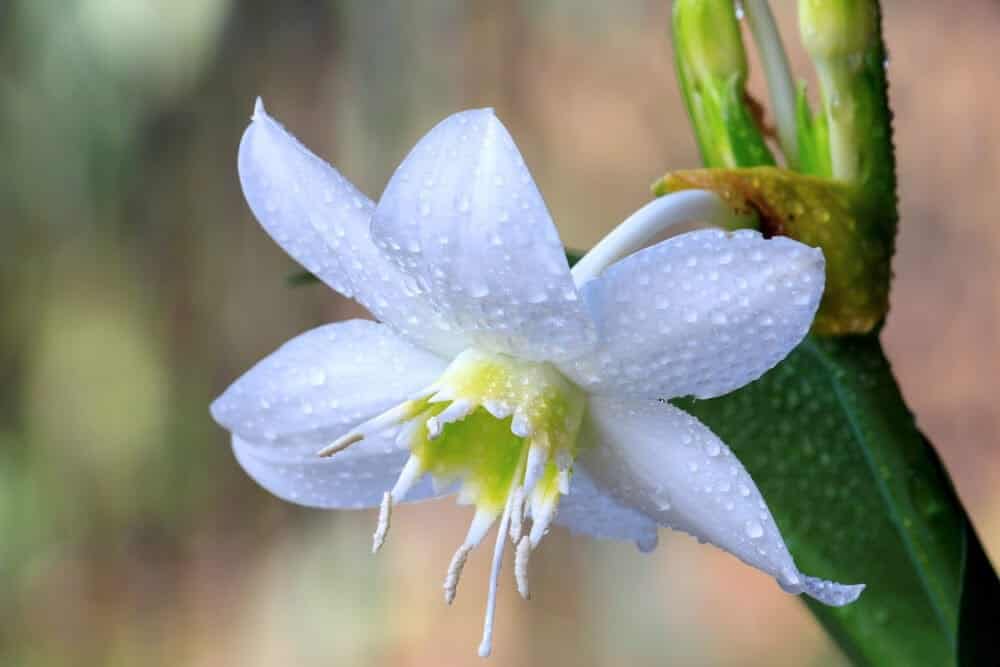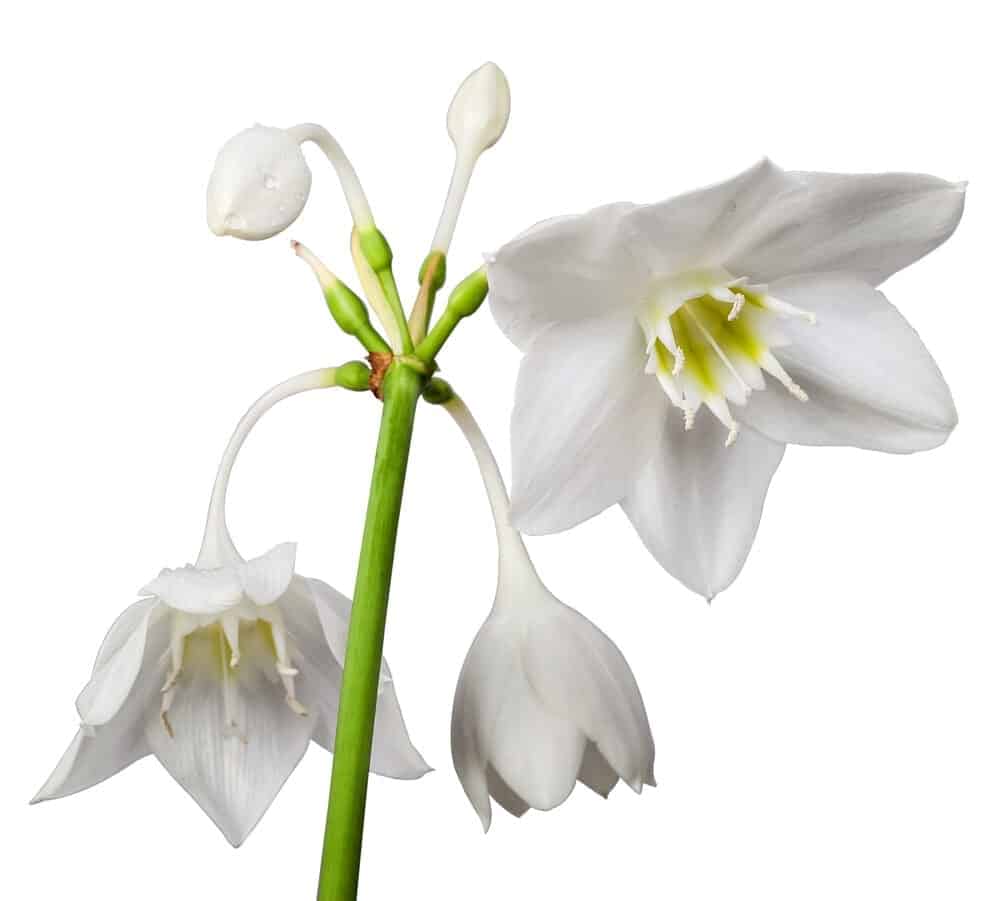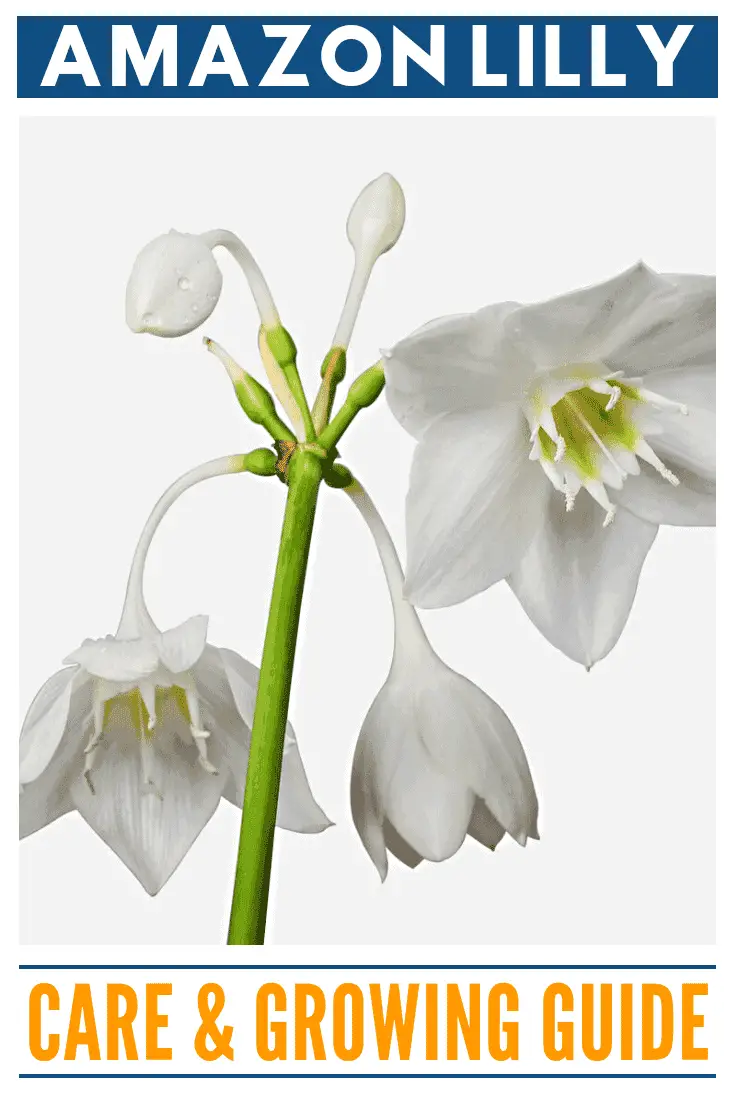If you want a flowering plant that is truly a showstopper, then you need to add the amazon lily to your indoor or outdoor garden.
It is a popular gift flower and can be found in many flower shops and grocery stores that sell bouquets.
Amazon Lily Care & Growing guide
1. Light requirements
Full but indirect light is the best type of light for this lily plant because the petals are delicate and can be harmed by the sun. If you plant this lily outside, it must be placed in a shady spot so that the sun does not harm the flowers.
2. Water
Although the lily likes to live in humid areas, if you overwater it, its leaves will droop, and its roots will rot. Water this plant once a week. The soil should be kept moist, especially if it is an adult plant. Water it more if the weather is hot. But when its flowers bloom, you should cut back on watering it so that the flowers don’t become waterlogged.
3. Climate and temperatures
Since this plant is from the Amazon, it loves to be in extremely humid weather, around 40% humidity. You can grow it outside, but if the area you’re in is not humid year-round, then the flowers will not bloom as often. It is best grown in a humid greenhouse or indoors. If the temperature drops below 50F, the flowers are likely to go dormant and not return until the following summer.
4. Soil
The soil for the Amazon lily must drain water away quickly. If it’s in a pot and grown indoors, be sure to add humus, some sand, and a bit of fertilizer to the potting soil. You must fertilize the lily three to four times a year, whether it is indoors or outdoors.

5. Repotting
If the lily is grown indoors, then it has to be repotted every three years or when the roots are wrapping around the pot from overgrowth. When you repot the lily, be sure to transfer it into a container that is not much bigger than the pot it is leaving. The roots of the lily do best when they are crowded.
6. How to propagate the Amazon lily?
If you want to propagate the lily and create new plants, you should harvest the offset bulbs from the lily and repot them in their containers. Offset bulbs are found around the roots of the lily and must be dug up. If you don’t dig up the bulbs, they could flower as they reach maturity and crowd the container.
7. Height and spread
The typical height of the Amazon lily is around 1 ½, but it can be taller or shorter depending on humidity and soil. It is not a bush plant, so its spread is about a foot in width. But as the flower gets older, the width of the plant should grow, especially if branches start to bloom more flowers.
8. How do I make the Amazon lily bloom?
The amazon lily truly has a beautiful flower and is worthy of its name. The flower is pure white with a yellow middle, and the whole flower is about 3 inches wide. The petals are glossy, have a bounce to them. Some people say that petals open up into a star shape. It blooms at different times throughout the years, and even in the winter. For the lily to bloom, the humidity must be high, and there should be fresh fertilizer in the soil.

How to trim the Amazon Lily?
Don’t trim the lily too often because it is prone to shock. At first, only cut out the dead or rotting part of the plant. Then cut off a few large leaves. But don’t do this all at once. Take a week in between maintenance so the lily can adapt.
Is the Amazon Lily poisonous?
Yes, the seeds, stems, and leaves of the Amazon lily plant are very poisonous and should be kept far away from children and animals. Plus, the flowers have a lot of pollen, which could activate a person’s allergies.
Can plants grow in water?
No, the Amazon lily cannot be grown in water. This lily does not like to be overwatered, because that will cause root rot and the flower to fall off. The most popular lily that can be grown in water is the water lily.
Common Plant Diseases and pests of the Amazon lily
Caterpillars are one of the most destructive insects you will have to fight to protect your lily plant. They love to eat leaves, and just a few of them can kill an entire plant. If you see small knicks and bites on the leaves of your Lilly plant, you should act immediately. Two ways to get rid of caterpillars is to either rub the leaves of the lily with need oil or spray the plant but not the leaves with dish soap.
Spider mites are another troublesome pest you must fight. Small yellow spiders will crawl around the leaves and stems. The leaves turn yellow and have webbing all around the plant. To get rid of spider mites, spray neem oil all over the stems, flowers, and leaves of the lily plant. Do not miss a spot. The neem oil gives off a terrible smell to bugs and spiders, and they can’t stand it.
Bulb rot happens when the roots of the lily are too wet, and fungus creeps up into the soil. The most apparent sign of bulb rot is if the flower of the plant started to turn yellow and curl up. If you have bulb rot, then you must take drastic measures to fight, or else the bulb rot will win. You have to replace the soil thoroughly, remove all infected bulbs, both old and new, and you must use a fungicide to keep it from coming back.
Conclusion
- The scientific name of the amazon lily is the Eucharis x Grandiflora.
- The petals of the flower sometimes point out to create a six-sided star.
- Colombia and The Andes in Peru are where this plant comes from.
- Another name for the Amazon lily is the Star of Bethlehem.
- Do not overwater the lily, because it will cause the bulb to fall off.
- Caterpillars love to eat the leave of this lily and must be kept away.
- Every part of the Amazon lily is poisonous, and you could wind up in the hospital with

Victoria is the owner and main author of hobby plants. She loves spending her free time in her garden planting and taking care of her plants. Victoria hopes you enjoy the content here!
![Why Are My Peace Lily Leaves Turning Brown? [EXPLAINED] Why Are My Peace Lily Leaves Turning Brown? [EXPLAINED]](https://www.hobbyplants.com/wp-content/uploads/2022/07/peace-lily-leaves-turning-brown-1-300x158.jpg)
![Mother Of Thousands Plant [Complete Plant Care Guide] Mother Of Thousands Plant [Complete Plant Care Guide]](https://www.hobbyplants.com/wp-content/uploads/2022/07/mother-of-thousands-plant-300x158.jpg)
![How Often Should You Water Pothos? [Complete Care Guide] How Often Should You Water Pothos? [Complete Care Guide]](https://www.hobbyplants.com/wp-content/uploads/2022/07/how-often-to-water-pothos-300x158.jpg)
![Can Snake Plants Live Outside? [COMPLETE CARE GUIDE] Can Snake Plants Live Outside? [COMPLETE CARE GUIDE]](https://www.hobbyplants.com/wp-content/uploads/2022/08/can-snake-plants-live-outside-300x158.jpg)
![Majesty Palm Plant Care: [Complete Beginner's Guide] Majesty Palm Plant Care: [Complete Beginner's Guide]](https://www.hobbyplants.com/wp-content/uploads/2022/08/majesty-palm-care-300x158.jpg)
![Exotic Angel Plant Care: [Complete Beginner's Guide] Exotic Angel Plant Care: [Complete Beginner's Guide]](https://www.hobbyplants.com/wp-content/uploads/2022/08/exotic-angel-plant-care-300x158.jpg)
![Do Coleus Like Sun Or Shade: [Complete Care Guide] Do Coleus Like Sun Or Shade: [Complete Care Guide]](https://www.hobbyplants.com/wp-content/uploads/2022/08/coleus-sun-or-shade-300x158.jpg)
![Snow White Waffle Plant: [Complete Care Guide] Snow White Waffle Plant: [Complete Care Guide]](https://www.hobbyplants.com/wp-content/uploads/2022/08/snow-white-waffle-plant-300x158.jpg)
![Waffle Plant Care: [Complete Beginner's Guide] Waffle Plant Care: [Complete Beginner's Guide]](https://www.hobbyplants.com/wp-content/uploads/2022/08/waffle-plant-300x158.jpg)
![Bird Of Paradise Plant Care: [Complete Beginner's Guide] Bird Of Paradise Plant Care: [Complete Beginner's Guide]](https://www.hobbyplants.com/wp-content/uploads/2022/08/bird-of-paradise-plant-300x158.jpg)
![Purple Passion Plant Care: [Complete Beginner's Guide] Purple Passion Plant Care: [Complete Beginner's Guide]](https://www.hobbyplants.com/wp-content/uploads/2022/08/purple-passion-plant-care-300x158.jpg)
![China Doll Plant Care: [Complete Beginner's Guide] China Doll Plant Care: [Complete Beginner's Guide]](https://www.hobbyplants.com/wp-content/uploads/2022/09/china-doll-plant-care-300x158.jpg)